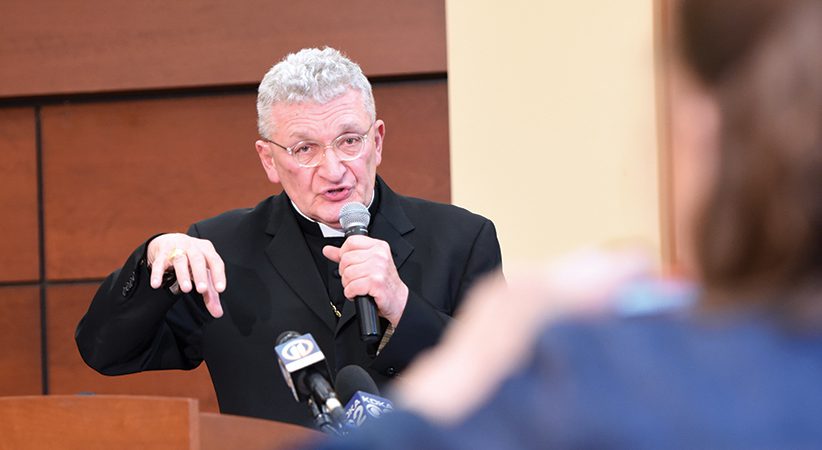Pregnant Silences
Living the Mass’s five movements of silence as priests
Father Boniface Hicks Comments Off on Pregnant Silences
When we examine the periods of silence and the silent prayers of the priest in the Mass of the Roman rite, we can identify five different movements of silence. These movements guide us to more fruitful interior participation in the Mass, as well as to a more fruitful expression of other aspects of our priestly life and ministry.
These five movements of silence are an ascetical silence of preparation (from before Mass through the introductory rites), a mystical silence of listening and encounter (during the Liturgy of the Word), a sacrificial silence of offering (during the preparation of the gifts), a contemplative silence of adoration and communion (during the Eucharistic prayer and Communion rite), and an eternal silence of savoring (in the concluding rites and after Mass).
Preparing and Focusing
The first period of silence is prescribed by the General Instruction of the Roman Missal to begin before Mass (No. 45). Preparation begins with silence in the sacristy for recollection as the priest internally prepares himself for celebrating the Mass. Silence helps us slow down and direct our focus. As we enter into the richly dense world of the liturgy, where words and ritual gestures are layered with meaning, we need to be able to slow down inside to participate most fruitfully. We will best engage the liturgy with our hearts if we step outside the streams of words and images that pour through our world in every quarter. As Pope Francis noted in his last encyclical, Dilexit Nos, “Living as we do in an age of superficiality, rushing frenetically from one thing to another without really knowing why, and ending up as insatiable consumers and slaves to the mechanisms of a market unconcerned about the deeper meaning of our lives, all of us need to rediscover the importance of the heart” (No. 2).
The silence in the sacristy is a first step in this process of returning to the heart as we enter the sacred mysteries. Subsequent steps in interior recollection are offered to us through the introductory rites after we begin the celebration of the Mass. One set of distractions that can interfere with our recollection are sinful thoughts and awareness of our past sins. For this reason, the liturgy instructs us to pause in silence for a few moments to acknowledge our sins and then cast them into the abyss of God’s mercy.
Another set of distractions that can keep us from entering into our hearts are the concerns that we bring with us into Mass. With all the responsibility we bear as priests, we can easily be weighed down as we feel the burdens of the people God has entrusted to us. For this, the introductory rites require another pause in silence before offering the collect: “Next the Priest calls upon the people to pray and everybody, together with the Priest, observes a brief silence so that they may become aware of being in God’s presence and may call to mind their intentions” (Roman Missal, No. 54, emphasis added). This silence should be long enough to unload those prayer intentions that weigh us down as we also become more consciously aware of the presence of God. It sounds strange to think that we could have arrived at this point in the Mass without becoming aware of the presence of God, but I have found that to be true so often in my own experience! Becoming aware of his presence at this brief point of silence can provide spontaneous relief — we do not bear these burdens alone.
This first movement of silence applies to our prayer of the Mass, but these same interior practices can also help us greatly before staff meetings, spiritual direction, preparing a homily or editing a bulletin.
Listening and Pondering
The next movement of silence is listening — to receive and ponder the mysteries proclaimed to us. This takes place in the Liturgy of the Word in which we expect to encounter God, who speaks through his word. The Church teaches in the Second Vatican Council, “He is present in his word, since it is he himself who speaks when the holy Scriptures are read in the Church” (Sacrosanctum Concilium, No. 7). It requires an act of faith to cultivate the expectation that we will encounter Christ in his word. It is worth asking whether our celebrations of the Liturgy of the Word foster this kind of faith-filled expectation.
This silence of listening can truly be described as “mystical” because we open our hearts to the revelation of divine mysteries. What we learn in this silent listening during the liturgy can also help us in our pastoral ministry. Opening our hearts to listen to the heart of another is what Pope Francis described as the art of accompaniment. The art of accompaniment “teaches us to remove our sandals before the sacred ground of the other” (Evangelii Gaudium, No. 169). It requires a self-restraint and silence for listening that Pope Francis acknowledged can even feel like a kind of martyrdom (Message for the 50th World Communications Day), but it radically transforms the way we relate with our people.
Uniting and Offering
Another important interior movement that plays an important role in liturgical prayer, and also finds expression in our priestly life and ministry, is the sacrificial silence of offering. Following the universal prayer, the priest sets the altar for the Eucharistic sacrifice. In the process of doing this, he is uniting his own offering and the offering of the faithful with the bread and wine that will become the very offering of the body and blood of Jesus Christ. The priest does this largely in silence, engaging several eloquent symbols of offering, including cut flowers, candles, incense, the mixture of water and wine and the remembrance of the white hot furnace from the Book of Daniel.
Each of these symbols carries a certain richness, touching various aspects of our lives that can be offered to God. Cut flowers, for example, are already dying. They are offering their lives to bring beauty to the altar. Candles are being consumed by the very fire that brings light to the sanctuary. Incense is made from the wounds of a tree; grains of incense, as dried tree blood, show us how God accepts our wounds as part of our offering. Our wounds are transformed into worship as they are touched by the fire of divine charity in the same way that incense gives forth a sweet, rising fragrance when it contacts the heat of the burning coals in the censer. The mystery of water and wine and the silent prayer that accompanies this gesture also remind us that our whole humanity is welcomed to become divinity as part of the offering. Lastly, the silent prayer of offering: “With humble spirit …” is taken from Chapter 3 of the Book of Daniel, in which the three young men are thrown into the fiery furnace. This is a powerful image of exactly what takes place at the altar — namely, that the priest is in the white hot furnace of divine love, which ought to consume him, but instead another appears who “is like a son of the gods” (Dn 3:25, RSVCE).
This silence of offering is also omnipresent in priestly life and ministry. The priest’s life, like the cut flowers or the candles, is daily dying in order to bring beauty and light to his people. The priest’s life is also marked by woundedness — his own and those of his people — that can be transformed through divine charity into worship and love. This is particularly true of the priest who continually receives the wounds of his people — for example, in pastoral counseling, requests for intercessory prayer, the Sacrament of Reconciliation and care for the sick and dying — gathering them up like grains of incense to be transformed into love and worship through the fire of divine charity.
Contemplating and Savoring
The final movements of silence in the Mass — a contemplative silence and a silence of savoring — express the importance of the priest’s personal prayer life. In private prayer, the priest can open his heart to the greatness of God’s love, even to the point of periodically being overwhelmed by the magnitude of that love. Whether it is through lectio divina or Eucharistic adoration, his daily Rosary or the Divine Office, the priest can encounter the Lord in a way that moves him to silent adoration. This openness to awe and wonder before beauty, truth and goodness must be a part of the priest’s regular life or he will find himself reduced to a functionary role rather than living as a steward of divine mysteries. In the Scriptures, the sacraments and the hearts of his people, the priest is handling sacred treasures that give him every reason for his awe and wonder to be daily renewed.
Similarly, the movement of silent savoring that marks the end of the Mass from after Communion to the private thanksgiving the priest is required to make after the final dismissal (cf. Code of Canon Law, Canon 909), has its corollaries in the daily life and ministry of the priest. In a day, the average priest spends extensive time in both the secular and the sacred. He encounters the sublime and the profane. Because the profane tends to be louder and brighter, it can often taint his initial lasting impressions from the day. With some time for silent reflection he can recover a sense of the sacred and take time to savor it, already leaning into his lot that will extend into eternity. Through all five of these interior movements, practiced in the Mass and lived in our daily life and ministry, silence is a necessary part of renewal and revitalization for us.
FATHER BONIFACE HICKS, OSB, is director of spiritual formation at St. Vincent Seminary in Latrobe, Pennsylvania, and director of the seminary’s Institute for Ministry Formation. His most recent book is “The Hidden Power of Silence in the Mass” (Sophia Institute Press, $18.95).





